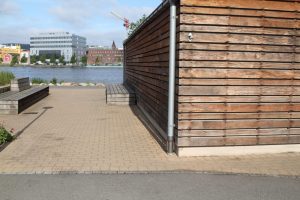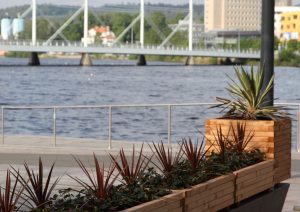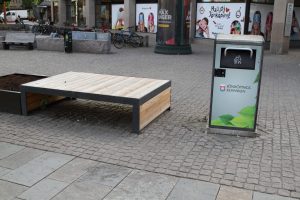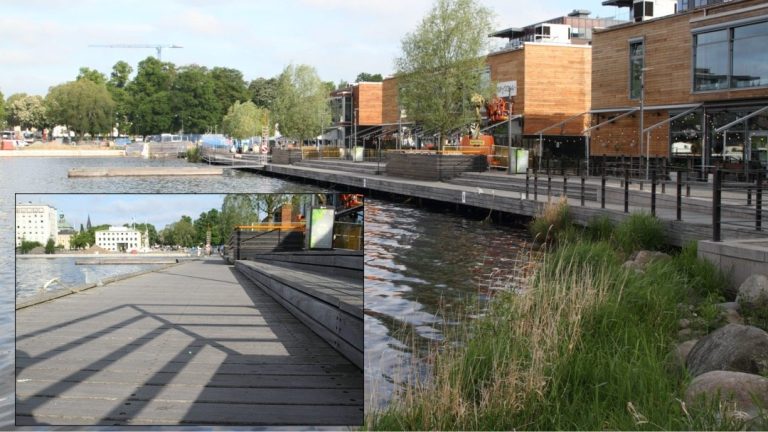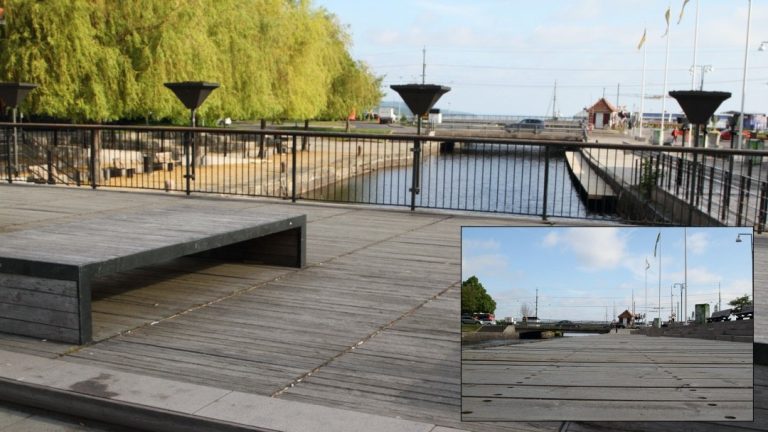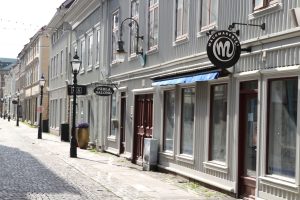Forestry people are often criticized for cutting down trees. But the people criticizing us actually contribute to the felling by buying wood and paper products. Not to mention by buying products that are packed and delivered in (mainly) paper products. Do they think of that at all out there? Are they aware of the whole picture?
How does the wood get there?
There is wood everywhere. Take a walk in your neighborhood and you will discover it. I did that – took a 10-minute walk from my apartment in the center of the town Jönköping in south Sweden, and I can promise you this: there-is-wood-everywhere!! Even close to my place that even I never thought about.
Sidewalks, flower boxes, benches, bridges, houses … do common people think about it? That there is wood everywhere and how it got there? I often think about what a German forester once told me about the young school class from the city who visited a forest. Their guide said: “This is where the wood that you have in your houses and furniture comes from.” The children quickly replied: “It´s impossible!” “Why?”, said the guiding forester. “Because wood is square, and trees are round.”
It´s a nice kind of logic I must say, and I take it that this school class learned a thing or two about wood processing this day. Actually, their teacher should have a medal for taking them to the forest. The earlier they learn, the better, and young children are more receptive than adults. Children are eager to learn, adults are not … at least not all of us.
Here are some photos from my morning walk today.
If they at all visit the forest
It can be very annoying to hear people complaining over the brush after a thinning or a clear cut disturbing their walking and jogging paths. Or their favorite place to pick berries and mushrooms. Most people don´t see the connection between the work being done in the forest and the paper bag they are carrying the mushrooms and the berries in. They want the berries but not the trouble of looking for them on a new spot.
Another comment I have heard from friends (with no connection to forestry) is: “Why are brush, bushes and dead trees left on clear cuts? It looks untidy.” It´s actually for the environment! The one you care so much about! Some people want the forest to be as tidy as their homes. These are the same persons who enjoys sitting on a wooden bench when they are in town.
How do we make people understand?
Somehow, we must make the public understand that everything we do has a negative impact on nature and environment. We must choose what’s least negative. If you cut down a piece of forest to build a house, you will have that forest back within 100 years in the northern hemisphere. The house will most likely still be there, after those 100 years, with the carbon stored in it.
If you instead choose to build your house of stone, you must take a piece of rock instead. How long does it take before that piece of rock grows back? Steel, concrete, and plastic (oil) also comes from the ground and takes quite a while before it comes back (if ever?). Which is the best option for the environment? How did the concrete and the steel get there? Does anyone ever think of that?
What you can´t see is not there
One “problem” that we have in forestry is that we operate above ground and on large areas. Anyone, who bothers to visit the forest or travels along country roads, can see what is being done. As for the mining industry, they operate below the ground level. They can go deep into, or even under ground, which make their operation less visible to the public. But their operation damages the nature more than forestry, and the material they extract doesn´t come back. But who cares if you can´t see it?
One of the major problems with humanity is that we compare everything to ourselves. I recall sitting in a bar in Germany when I lived there and operated harvesters. A guy who I just told I was thinning a 40-year-old pine stand, asked me “How does it feel to cut down trees twice your age?” Apart from that he underestimated my age, I had to inform him that a 40-years old pine tree is not an old tree. A scots pine can be 700 years old. A Norwegian spruce can be 300 and an oak 1000 … Why do we compare the forest to ourselves?
As a Swede, I must confess that we cut down all old forests a long time ago. To repair that mistake it has been decided that we leave at least 10 “storm proof” trees per hectare to grow old, so called eternity trees. We have done that for 25 – 30 years now. People´s sense of logic shines through when they tell me “We must restore the old forests!!” I agree, but to make people understand that it takes x-hundred years to do that is a challenge. And here we are talking about teachers and engineers who really should be able to do the math’s.
How do we inform the public?
To make people see the whole picture – that is the big challenge if you ask me. I have confronted youngsters who are handing out flyers with “save the forest” messages with that their flyers most likely contains at least 10 – 20 % virgin wood fibers, meaning that trees had to be cut to make the flyers. They don´t believe it, because they don´t want to and they don´t have to (if you ask them).
One of them had an iPhone, so I informed him that iPhones are delivered in cardboard packages made of 100 % virgin wood fiber, just like Ikea furniture (and many others). So, by buying those companies’ products you contribute to that trees are being cut. But those big companies demand this from their cardboard suppliers because it´s the most environmentally friendly packages you can get. Did he believe me? He was very polite but no, he didn´t believe me. Did he go home and check the net for facts about it? I don´t know, I hope so, but I doubt it.
Speaking of paper, recycled paper is good but does anyone think about how old magazines and newspapers are transformed into white paper? Where did all the colors go, all the ink that was printed on the paper? Is that process really more environmentally friendly than cutting fresh fiber in the forest?
An uneven fight
It´s an uneven fight we have to struggle. To keep informing and concentrate on facts is the only way if you ask me. Bringing young school children to the forest like the German example above, is a good idea, but also to confront the critics with facts.
Personally, I like the questions: “How does it get there?” and “What are the alternatives?” If you are in a discussion with someone about this, keep a lookout for iPhones and Ikea furniture and present the facts.
Let´s face it – the best for the nature would be if humanity disappeared from the face of the earth. It´s hard but it´s true. But who wants that? I don´t. We simply must find a way to utilize our natural resources in a sustainable way. The forest is most suitable for that, and we must make people understand it.
Photos: Per Jonsson






